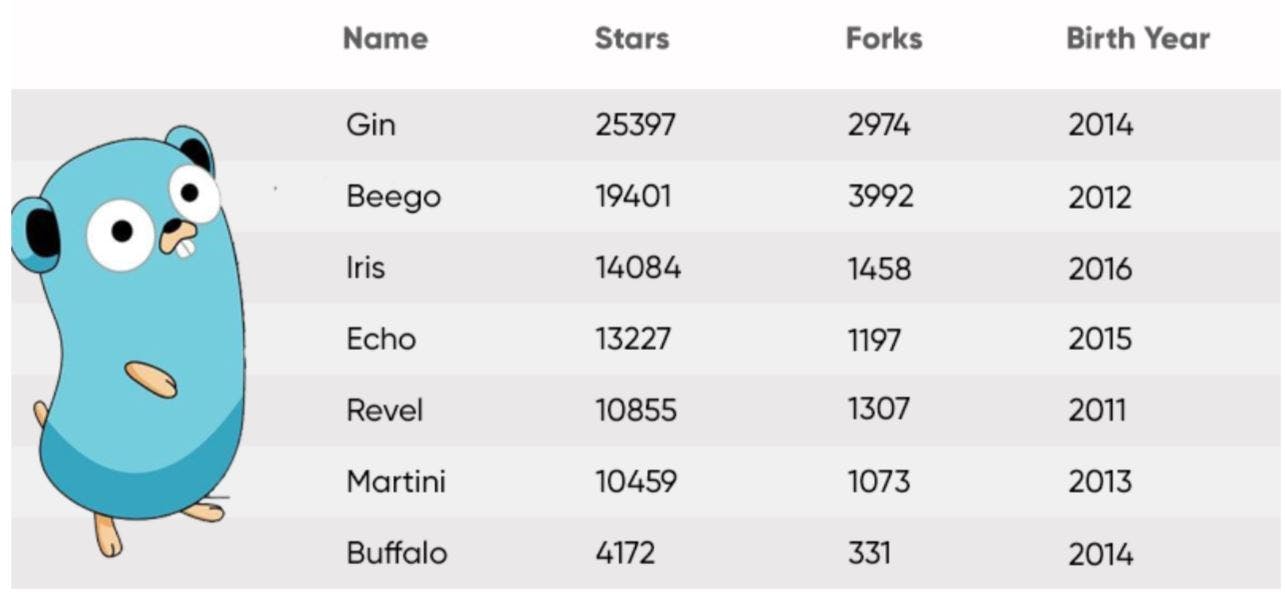Go is not meant to innovate programming theory. It’s meant to innovate programming practice.
Go was created by Google about ten years ago when they were experiencing extremely long wait times for C++ to compile.
Since this created a bottleneck, they decided to find a solution which was an entirely new programming language.
Basically, they took all of the things that make C++ so great, most notably performance and security features, and combined it with the speed of Python.
Go eschews features, cleverness and flexibility in favor of ruthless pragmatism and simplicity.
Why Use Golang?
Let’s take a look at some of its benefits:
- Great for web development
- Great for command line scripting
- Can be used for network server applications
- Can be used for front-end development

Go frameworks
gin
The gin framework is mostly used for building a REST API for the backend if the programmer wants to develop a single page application using a frontend framework. This framework makes use of the HTTP routers for handling the Golang traffic and is ideal for beginners along with its rich documentation provided on GitHub. It supports the most essential libraries and features which makes it the most suitable Golang framework to develop high-performance REST APIs.
revel
Revel is designed to come out of the box with much of its feature-set pre-configured and installed for optimal functionality. This means that you can get going pretty much with no setup, which is very appealing for many startups and small groups.
Likewise, Revel doesn’t require very many third party libraries or middleware implementations in order to do complex tasks, which, unlike some entries on this list, means that it’s relatively self contained. By packaging everything together out of the box and ensuring even complex tasks can be done with the default installation, Revel seems to be positioning itself as a “one stop shop” solution.
martini
Martini is extremely lean, but unlike Gin, boasts impressive and easy to integrate third party support. These additional libraries take what is the otherwise incredibly lean Martini code base and allow it to magnify and leverage its functionality to be something more than just its components. This additional third party support makes Martini less of a framework like Gin, and more like an ecosystem, like Revel.
That’s the last of the similarities with Revel, however. Martini is very lean by design, and is meant to do a lot of work with a minimal amount of overhead. This means that it occupies a space somewhere between enterprise and small team programming, offering good scalability.
Martini also offers a wide range of support for routing methodologies and formats, and offers support for wildcards, variable parameters, regex stricture, and more. This makes it arguably more powerful than Gin for not much more overhead.
mux
It implements the http.Handler interface so it is compatible with the standard http.ServeMux.
Requests can be matched based on URL host, path, path prefix, schemes, header and query values, HTTP methods or using custom matchers.
URL hosts, paths and query values can have variables with an optional regular expression.
Registered URLs can be built, or “reversed”, which helps maintaining references to resources.
beego
The beego framework is used for the rapid development of REST APIs, web applications, and backend services in Golang.
It is often viewed similarly to the Django web framework in Python and contains specific features of Golang such as interfaces and struct embedding. It does not require any third-party installations.
kit
The kit framework is a programming toolkit for building robust, reliable, and maintainable microservices in Golang.
It is a set of packages and best practices, which provide a comprehensive, robust, and trustable way of building microservices for organizations of any size. Go is a great general-purpose language, but microservices require a certain amount of specialized support.
Fast HTTP
Fast HTTP package is tuned for high performance with zero memory allocations in hot paths. Performance wise, it is upto 10x faster than net/http
Features
Optimized for speed: Easily handles more than 100K qps and more than 1M concurrent keep-alive connections on modern hardware. Optimized for low memory usage.
Server provides many anti-DoS limits like concurrent connections per client IP, number of requests per connection and many more.
mango
Mango framework helps you develop reusable modules of HTTP functionality as easily and fast as possible.
Moreover, it comprises of a list of apps and middleware into one HTTP server object for keeping your code autonomous.
Gocraft
Gocraft is one of the traditional Golang web frameworks that offers quick and scalable routing options to various programs created using a combination of functionalities.
With the help of a standard library or HTTP, the developers can add numerous routings with the liberty of adding extra functions to it.
For the programmers who are looking to enhance the performance of API in a solution, a Gocraft framework is surely an ideal option.
Buffalo
Buffalo is one of the frameworks for the Golang language that has garnered traction lately. Apart from allowing developers to get started with projects rapidly, it also enables programmers to initiate with dev command and automatically observe binary files. If we compare other Golang frameworks for web development with Buffalo, it is pretty fast and syncs with the whole ecosystem well. In short, Buffalo is a framework that provides a holistic approach to web development.
